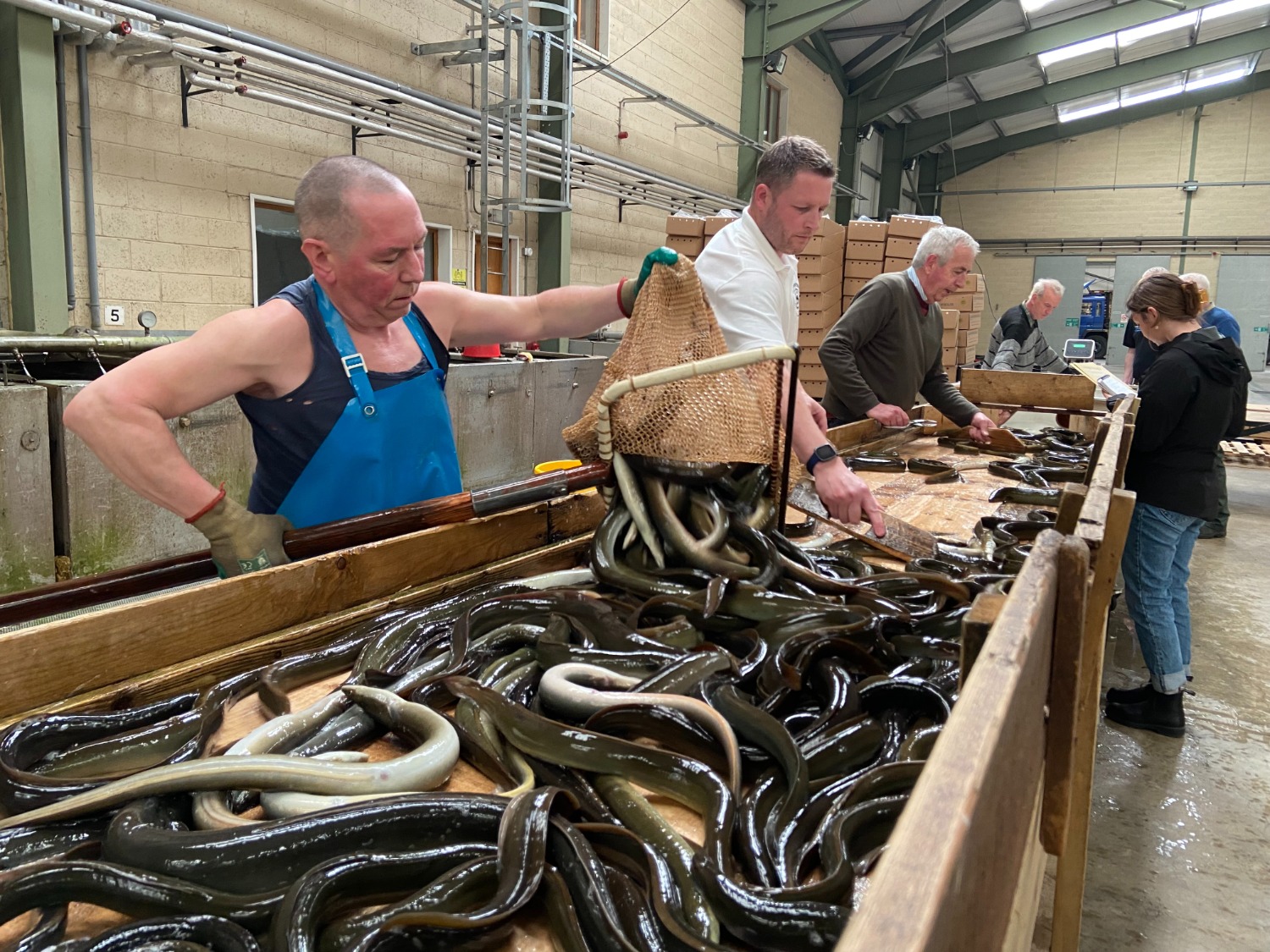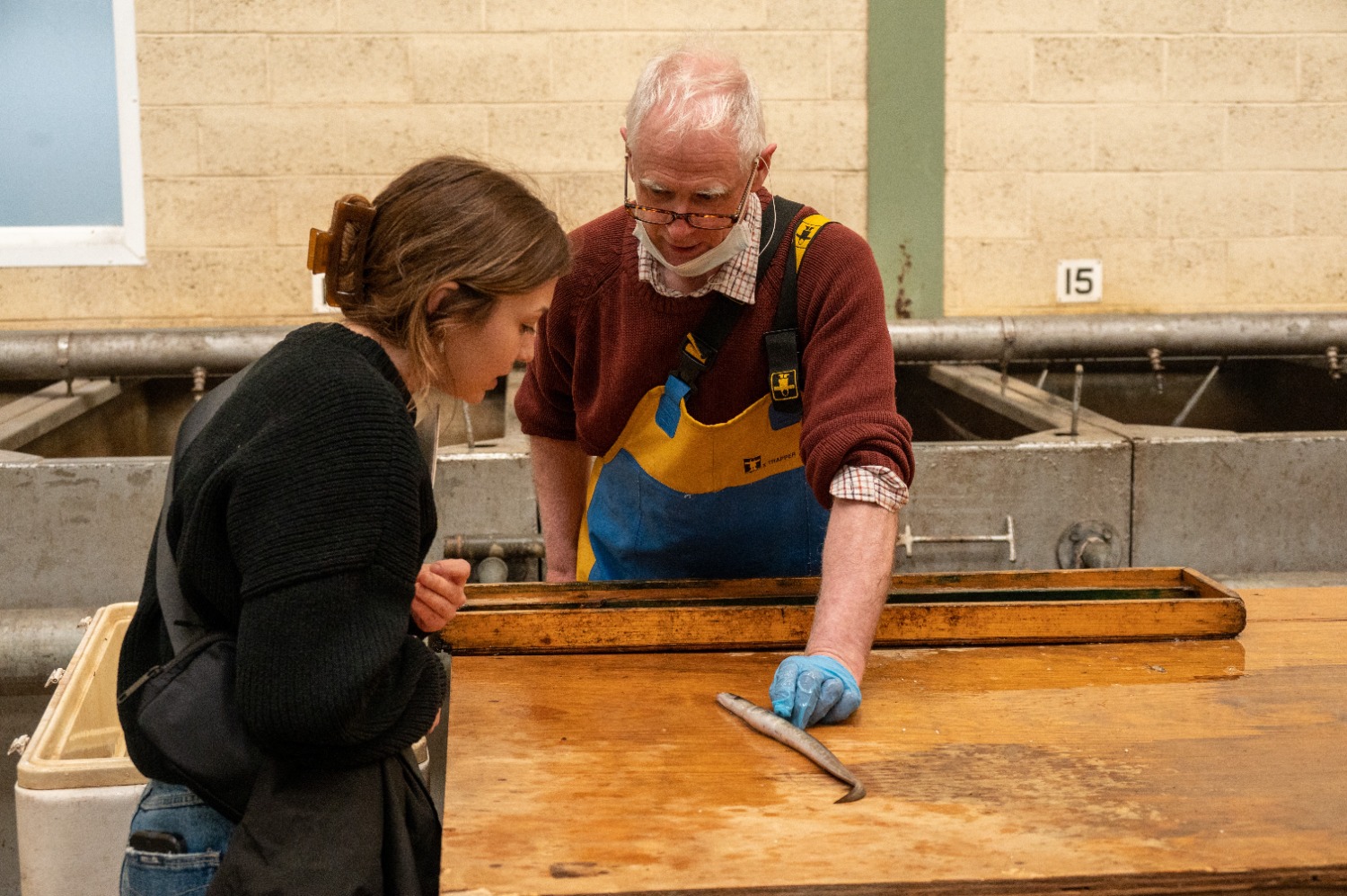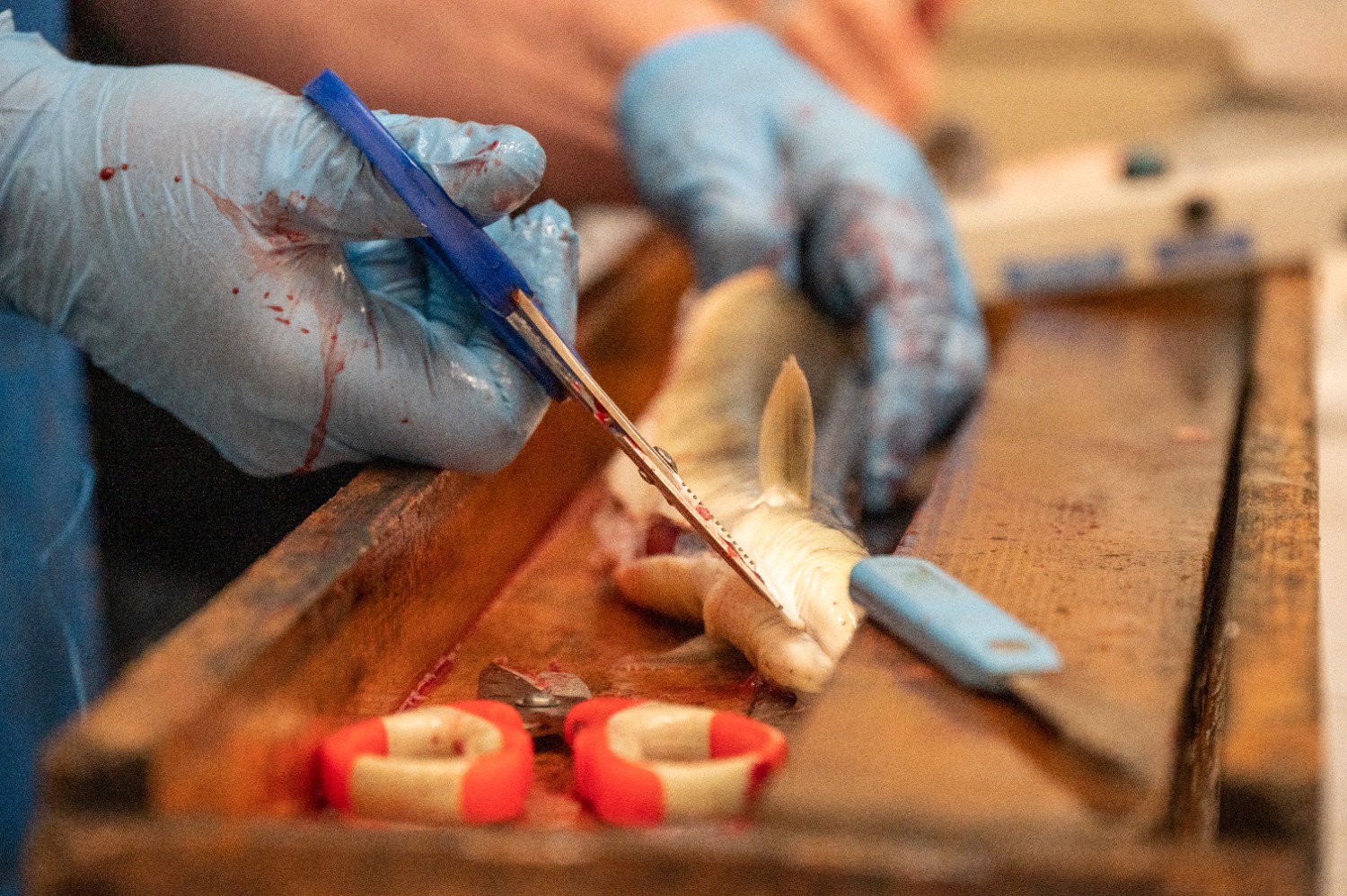On an early afternoon in May, with the sun hiding behind a few clouds, a dozen passengers on a small tour boat listened as their captain told the history of eel fishing on Lough Neagh, the biggest freshwater lake in the United Kingdom and home to the largest wild eel fishery in Europe.
Gary McErlain’s family has been fishing for eels commercially on Lough Neagh, about 30 miles from Belfast, for seven generations. McErlain and his wife, Anne-Marie McStocker, who both grew up in small communities around the Lough, started doing boat tours in 2020. She sometimes takes over when her husband gets emotional about all that’s happened to his family and their industry. Now they’re facing a new hurdle: Brexit.
The emotional part comes after McErlain tells the story of his ancestors pushed to the lake’s edge during the plantation of Ulster in the 1600s, when the land was divided up among British and Scottish settlers. It comes when he talks about his great-great grandfather in the 1800s, when his fishing rights were, McErlain said, stolen from him by British companies. McErlain, like many where he lives, is not a fan of Great Britain, past or present.

Andy Mepham
“Our fishing licenses are handed down as an ancestral thing over generations,” said Anne-Marie, who grew up in a Cargin, a small townland right outside of Toome, as a fishermen’s granddaughter and has re-entered the industry to help her husband. “It’s who we are, it’s what our families have always done. We weren’t just going to wave goodbye to it, so of course we were going to be anti-Brexit.”
Along with 95 percent of the eel fishermen on this lake, the McErlains/McStockers are members of the Lough Neagh Fishermen’s Co-Operative Society, whose mission is to maintain what’s now a 9,000-year-old way of life.
The LNFCS was founded in 1965 to buy back the fishing rights, and now must navigate the murky waters of the Brexit deal and the Northern Irish Protocol, which essentially put a border in the Irish Sea in order to avoid a hard border between the Republic of Ireland, still in the EU, and NI, still in the UK.
Of the 400 tons of eels caught annually on Lough Neagh, 80 percent are exported to EU countries. The smaller eels are sold to Holland and Germany to be smoked and treated as a delicacy. Most of the non-EU trade happens when the majority of larger eels are sold to London to be jellied and used in traditional dishes.
When the United Kingdom left the European Union in a still-ongoing process, exporting eels to Holland, Germany, and even London became a difficult task.
Pat Close is head of operations at the co-op. “During the 2017,18,19 period – it was all uncertain. There were a lot of sleepless nights,” he said. “We have about 250 fishermen, they wanted to know what was likely to happen as each year came along.”
The protocol allowed for Northern Ireland to continue to trade with Europe and allowed the co-op to retain access to 80 percent of their market on the European mainland.
While the co-op retained access to 80 percent of their market, questions remained about how to deal with the 20 percent of their regional catch that still went to Britain.

Andy Mepham
The difficulties added on to another development: In 2007, after a significant decline in the eel population across the continent, Europe classified the eels as an endangered species under the Convention of International Trade of an Endangered Species, or CITES.
The CITES classification created more restrictions and regulations on eels, basically limiting trade to Europe. With Brexit and Great Britain no longer a part of the European Customs union, the co-op was stuck on what to do about British exports.
“Immediately we lost 20 percent of our market. We’re reasonably happy to still have 80 percent but we needed the other 20 because that included fish of a size the European market is not particularly interested in,” Close said.
Two years after Brexit was enacted and after not a little bit of paperwork, the co-op has mostly figured it out and returned to where these fishermen were in terms of trade with the European and Great Britain markets – with added daily permits and extra costs.
It’s one more way the co-op’s adapted following the 30-year decline in the number of juvenile eels, or elvers, in Lough Neagh.
Historically, the co-op recorded around 12 to 15 million elvers coming back from the sea into the river system to eventually make their way into Lough Neagh, but in 1983, that number dropped and has not recovered. The present annual average recruitment of elvers is around 2 to 3 million.
The CITES classification and Brexit made it hard to keep the lake stocked – trade questions also affected importing elvers – because, as McErlain, McStocker and Close all attest, ending eel fishing here isn’t an option.

Andy Mepham
In 1984, in an effort to conserve the species and the livelihood and culture of its members, the co-op started buying juvenile eels from Great Britain and France from a surplus of elvers in their river systems.
Importing the elvers hasn’t been an easy process, and not a cheap one. The co-op has spent $6 million in the past 30 years stocking the lake with more than 100 million juvenile eels, which wasn’t necessary before the ‘80s, said Close.
Apart from the funding the co-op gets from a percentage-based stocking levy from fishermen’s earnings for the year, it relies on government aid and funding.
In recent years, Close said the co-op received grant aid for the restocking program from various sources of European funding, but since leaving the EU, the grant aid stopped.
The co-operative has applied for funding within the UK but has yet to be approved for the next year.
For years, the co-op did business with Great Britain to import eels into the lake, but when Great Britain left the EU, the supplier struggled to supply to Northern Ireland and other fisheries in the EU.
Close said the co-op turned to France for some of what it needed, but the eel season there runs from December to January, too early for the lake because the temperature is not warm enough yet. The French eels were also more expensive, and the quality was not as good, he said.
This year, after jumping through many hoops, authorities have let the co-op do a trial run with Great Britain to again stock the lake. The issue then became customs arrangements.
The only ports of entry for imports were seaports, not airports. When dealing with a live species, you need to get it to where it needs to go as fast as possible. At every port, there are also numerous papers needing boxes checked, said Close
Since road transport was the only way to stock from Great Britain, the supplier had to take a 36-hour round trip that included an overnight stay and a ferry crossing. The co-operative spent £150,000 stocking 1.6 million glass eels this year, a big investment, said Close.
They did not make the investment lightly; Close said he knows uncertainty surrounds the future of his industry. But it also can’t turn away from the history and meaning to this lake and village, which is an epicenter of the eel trade.
When Europe imposed the Eel Management Plan, rules all eel fisheries in Europe need to follow to help restore the population, commissioners looked to the co-operative for insight. It’s seen as a forerunner for eel sustainability, said Close. The fishermen have a strict daily catch quota. The day’s catch is then transported by truck to the co-op headquarters. On a visit in May, visitors watched the slippery eels slither out from the truck onto a trough where they’re sorted by size.
The small eels are gripped by metal clamps and thrown onto the cement floor to make their way to a grate that will feed them back out to the lake to develop further. The co-op can’t keep any eels under 40 centimeters in size. Meanwhile, hungry herrings have picked up on the small-eel escape route and now many have free lunch most days.
After being sorted, the co-operative is required to release 40 percent of mature silver eels back to the lake so they’ll be able to escape to the Sargasso Sea.
The 3,000 mile journey takes many years. The eels sense the earth’s magnetic energy to return to the place they were born in order to reproduce.
The eels are ready to make the journey once all of their fat is recycled into reproductive organs. Female fish are mature at 18 years old and males are mature at 12.
Researchers come once a week to study and ensure the health of the population.

Andy Mepham
During one recent visit, Derek Evans, a senior fishery scientist, and two other researchers took data on two random batches of unsorted eels. They measured all the eels in both catches then picked a lucky 10 to examine.
The 10 got measured again, weighed, analyzed for fat content, and then dissected to search the swim bladder for parasites.
The researchers, the fishermen, several governments and people around the Lough all care about the health of the eels in their lake. It’s a big part of what defines where they live.
While the tour boat manned by McErlain gently drifted on the lake, large crowds of locals and visitors wandered around various tents set up showcasing arts, crafts and food inspired by the landscape. It was Sunday, May 22, the first ever Lough Neagh Artisans Market in Toomebridge or Toome – it’s known as both.
Oran Johnston, owner of Gran’s Cafe on Main Street, hosted a traditional eel supper. Johnston and his dad sold out of 45 plates.
Johnston bought his eel from the co-operative, and it still took him and his dad eight hours to prepare the finicky fish.
If not prepared correctly, it will ruin the taste for people forever, he said.
Johnston put it in the oven for 50 minutes, then finished off the eel chucks by putting them in a pan, no oil. The eel produces so much of its own, there’s no need to add any to the pan.
At his cafe, Johnston works in the morning while his father is out fishing on the lake. He often waits at work for a text from his dad around noon to let him know that he’s back from fishing and is preparing the fresh-caught eel for breakfast.
Conor McMeel, a Toomebridge resident for the past 30 years, remembers when his dad would skin the live eels and throw them in a pan.
His dad would then keep the oil. Many older generations around the lake swear the naturally produced eel oil has arthritis healing benefits. Some also tan the eel skin.
Eels are an integral part of the history and culture to the people and fishermen in the communities surrounding Lough Neagh.
Many younger fishermen, like Gary McErlain and Anne-Marie McStocker, can’t make a living by fishing the way people used to. McErlain also has a second job as a landscaper and McStocker is a substitute teacher. And they run the tours now.
Worried about the dwindling number of young fishermen joining the industry, the couple started the tours to educate people about the history and significance of eels in the lake. The couple wants to tell a story in the purest form because the fishing community has gone through so much to protect the people, the eels, the lake and the fishing.
“Now is the time to make people aware of what has happened… it’s time to tell a story in a way only fishermen can tell,” McStocker said.